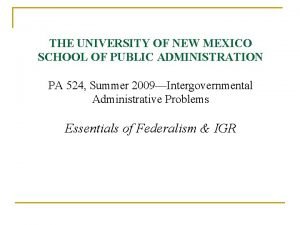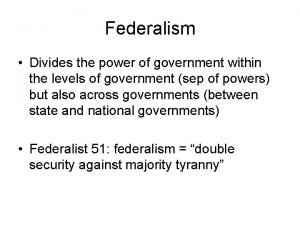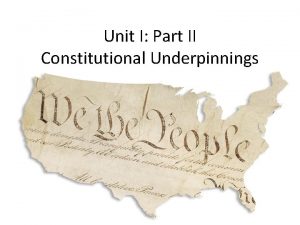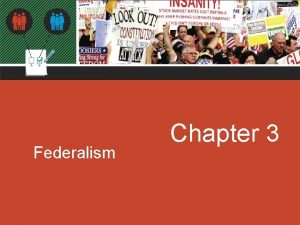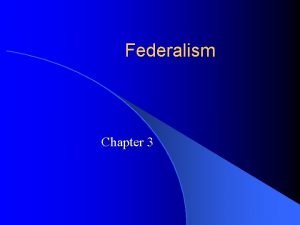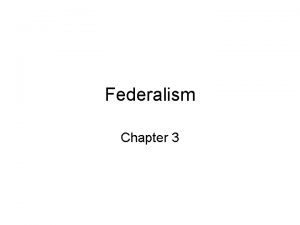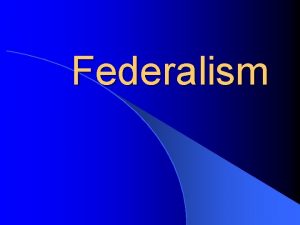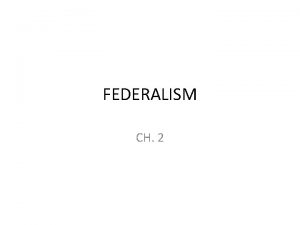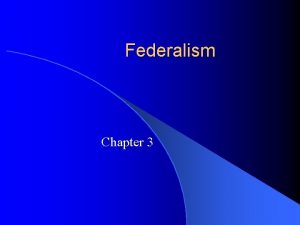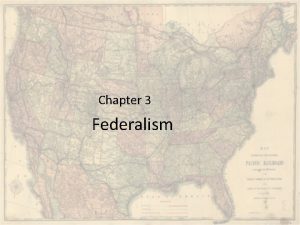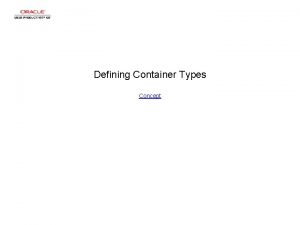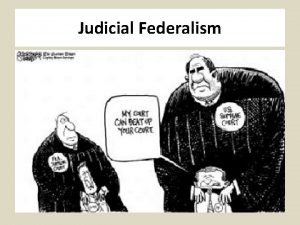Defining Federalism Types of Federalism and Intergovernmental Relations















- Slides: 15

Defining Federalism Types of Federalism and Intergovernmental Relations

Defining Federalism l What is Federalism? – Definition: A way of organizing a nation so that two or more levels of government have formal authority over the land people. l Intergovernmental Relations- – Definition: The workings of the federal system- the entire set of interactions among national, state and local governments.

Defining Federalism Unitary Confederate Federal Central Holds primary Limited powers authority regarding states Regulates activities of states Shares power with the states State Little or no powers Sovereign Regulated by Allocate some central government duties to central government Shares power with the central government Citizens Vote for central government officials Votes for both state & central officials Vote for state government officials From Table 3. 1

Defining Federalism l Why is Federalism So Important? – Decentralizes our politics l More opportunities to participate – Decentralizes our policies Which government should take care of which problem? l States can solve the same problem in different ways. l

The Constitutional Basis of Federalism l The Division of Power – The U. S. Constitution – Laws of Congress – Treaties – State Constitutions – State Laws

The Constitutional Basis of Federalism l Establishing National Supremacy – Implied Powers – Commerce Powers – The Civil War – The Struggle for Racial Equality

The Constitutional Basis of Federalism l States’ Obligations to Each Other – Full Faith and Credit – Extradition – Privileges and Immunities

Intergovernmental Relations Today l Dual Federalism – Definition: A system of government in which both the states and the national government remain supreme within their own spheres, each responsible for some policies. – Like a layer cake – Many argue this ended in the 1930’s?

Intergovernmental Relations Today l Cooperative Federalism – Definition: A system of government in which powers and policy assignments are shared between states and the national government. – Shared costs – Shared administration – States follow federal guidelines

Intergovernmental Relations Today l Fiscal Federalism – Definition: The pattern of spending, taxing, and providing grants in the federal system; it is the cornerstone of the national government’s relations with state and local governments. Figure 3. 2

Intergovernmental Relations Today l Fiscal Federalism continued: – The Grant System: Distributing the Federal Pie l Categorical Grants: Federal grants that can be used for specific purposes. They have strings attached – Project Grants- based on merit – Formula Grants: amount varies based on formulas Block Grants: Federal grants given more or less automatically to support broad programs. l Grants are given to states & local governments l

Intergovernmental Relations Today l Fiscal Federalism continued… – The Scramble for Federal Dollars $300 billion in grants every year l Universalism- a little something for everybody l – The Mandate Blues Mandates are the “strings” attached to federal money l Unfunded mandates are requirements on state & local governments- but no money l

Understanding Federalism l Advantages for Democracy l Disadvantages for Democracy – Increasing access to – States have different government – Local problems can be solved locally – Hard for political parties / interest groups to dominate ALL politics levels of service – Local interest can counteract national interests – Too many levels of government- too much money

Understanding Federalism Figure 3. 4 (1999 average: $6, 734)

Understanding Federalism l Federalism and the Scope of Government – Which level of government is best able to solve the problem? – Which level of government is best able to fund solutions to the problem?
 Federalism definition ap gov
Federalism definition ap gov Deil wright models of intergovernmental relations
Deil wright models of intergovernmental relations Examples of non defining relative clauses
Examples of non defining relative clauses Relative clauses defining and non defining
Relative clauses defining and non defining Non-defining relative clauses
Non-defining relative clauses Defining and non defining relative clauses in telugu
Defining and non defining relative clauses in telugu Nominal relative clause
Nominal relative clause Adjectival clauses
Adjectival clauses Intergovernmental organization (igo)
Intergovernmental organization (igo) Intergovernmental child support
Intergovernmental child support Intergovernmental grants department
Intergovernmental grants department Employee relations in public relations
Employee relations in public relations Features of federalism
Features of federalism Federalists definition
Federalists definition Cooperative federalism
Cooperative federalism Constitutional underpinnings definition
Constitutional underpinnings definition

